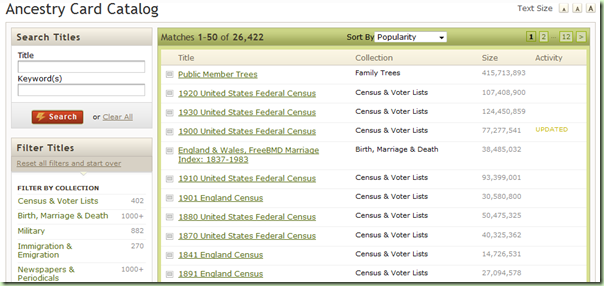The New Ancestry Card Catalog is not only useful for finding titles of interest, it conveys an amazing amount of information. To search for a title, enter important words from the title or one or more keywords in the Search Titles box in the upper-left corner. Alternately, one can browse a list of titles shown on the right side of the page. Ancestry.com has historically used the term databases, but with the addition of book and newspaper images, title is a better way to talk about their databases. (Oops. I can see it's going to take me a while to break that habit.)
When you first come to the card catalog, the number of matches indicates the number of titles (databases) on Ancestry.com. At the time of the screen shot above, there were 26,422.
The list can be sorted a number of interesting ways. You may sort by Date Added and see the most recent new databases (I mean titles). You may sort by Date Updated to have updated titles added to the list of new titles.
Unlike the recent database list, some aspects of the card catalog are not updated in real-time. For example, an odd book titled "not listed" was published during the day of 1-Oct-2008 and was not yet in either old or new catalogs. (That's a bug. Once Ancestry.com removes that database, the link might not work any longer. At that point, try searching the catalog for the most recent database.)
I also noticed that database size was set to zero for all book titles going back from 1-Oct-2008 (the day I'm writing this part) back to 30-Aug-2008. Either that's another bug, or they have a process that updates name counts once a month for books.
Sort by popularity and see what are the most popular titles on Ancestry.com. As of the time of the illustration above, they were
- Public Member Trees
- 1920 United States Federal Census
- 1930 United States Federal Census
- 1900 United States Federal Census
- England & Wales, FreeBMD Marriage Index: 1837-1983
- 1910 United States Federal Census
- 1901 England Census
- 1880 United States Federal Census
- 1870 United States Federal Census
- 1841 England Census
Sort by Record Count and you can see the largest databases. On the day I tried it, they were
| Title | Size |
| Ancestry World Tree | 467,671,004 |
| Public Member Trees | 415,713,893 |
| | 626,564,248 |
| British Phone Books, 1880-1984 | 278,407,920 |
| OneWorldTree | 192,141,453 |
| 1930 | 124,450,859 |
| Private Member Trees | 109,439,127 |
| 1920 | 107,408,900 |
| 1910 | 93,399,001 |
| | 82,888,619 |
Having sorted by record count, one would assume that the Size column shows the number of database records. Notice, however, the anomalously large size of "U.S. Phone and Address Directories, 1993-2002." That appears to be a name count, rather than a record count. Divide it by two and you'll get the record count. (Don't worry, I'll explain why in the future.) The other databases appear to have one name per record, so after converting the counts to record counts, they are sorted in record count order, as requested.
I assume this will also get fixed once it is noticed. One article, three bugs. When I was an Ancestry.com employee, I would have reported these directly to the responsible individual who often would have them fixed before my article "went to press." Sorry, ol' friends; I'll have to air a little dirty laundry now. Hopefully you're following my column and will have these bugs fixed before half my audience gets around to seeing if they still exist.

No comments:
Post a Comment
Note: Only a member of this blog may post a comment.